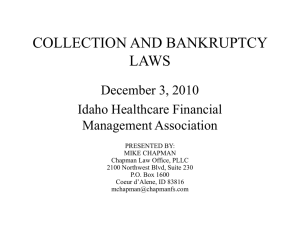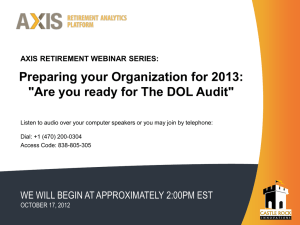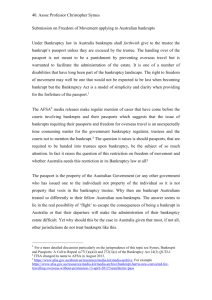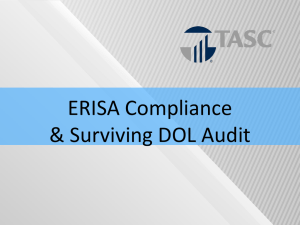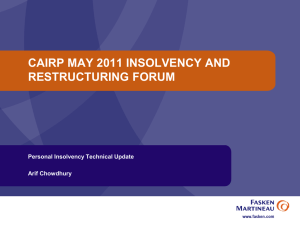View Marcia Wagner`s PowerPoint presentation here
advertisement
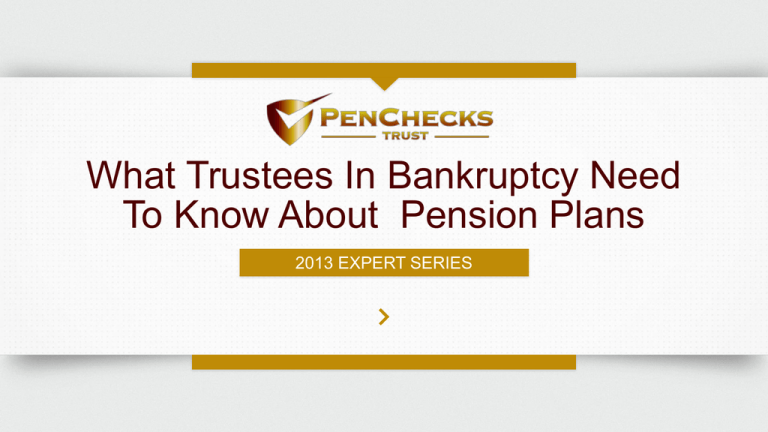
What Trustees In Bankruptcy Need To Know About Pension Plans 2013 EXPERT SERIES Our Path 1 Background on Bankruptcy and Retirement Plans 2 Plan Termination Considerations for Bankruptcy Trustee 3 Proposed Expansion of DOL’s Abandoned Plan Program 4 Best Practices for Bankruptcy Trustee Our Speakers Marcia Wagner Mike McWherter Managing Director Wagner Law Group Chief Compliance Officer PenChecks Inc. disclaimer These materials have been prepared for informational purposes only and constitute neither legal nor tax advice Transmission of the information is not intended to create, and receipt or attendance at any presentation does not create or constitute, an attorney-client relationship Anyone viewing this presentation or reading these materials should not act upon this information without seeking professional counsel In response to new IRS rules of practice, we hereby inform you that any federal tax advice contained in this writing, unless specifically stated otherwise, is not intended or written to be used, and can not be used, for the purpose of (1) avoiding tax-related penalties or (2) promoting, marketing or recommending to another party any tax-related transaction(s) or matter(s) addressed herein. Background on Bankruptcy and Retirement ERISA Fiduciary Duties Imposed on Bankruptcy Trustee • • • • Code Section 541(b)(7) excludes plan from estate BAPCPA of 2005 added Code Section 704(a)(11) 1 Trustee must serve as plan’s ERISA “administrator” 2 DOL Position: Trustee is plan fiduciary 1 Bankruptcy Abuse Prevention and Consumer Protection Act of 2005 added several new duties to Chapter 7 bankruptcy trustees, including a new plan-related duty under Section 704(a)(11) of the U.S. Bankruptcy Code. 2 ERISA Section 3(16). Conflict between ERISA and Bankruptcy Code • Duty to participants vs. duty to creditors and debtor • Personal liability for fiduciary breaches under ERISA • Immunity for trustee acts authorized by bankruptcy court DOL’s Position in Bankruptcy Court • Court cannot authorize specific acts to terminate plan • Court cannot order fee payment from plan assets • Trustee cannot be released from ERISA liability Plan Termination Considerations for Bankruptcy Trustee Plan Termination and Potential Fiduciary Liability • Trustee may be personally liable for any participant losses • Heightened risk exposure when plan assets are liquidated • Fiduciary duty to maintain tax-qualified status and file 5500s Plan Documentation • • • • Resolution to terminate plan Amendment to update plan for qualification purposes IRS amnesty program for late amendments (EPCRS) 3 Consider IRS determination letter submission (Form 5310) 3 IRS Employee Plan Compliance Resolution System. Form 5500 Requirements • Annual 5500 filings and related financial audits • Final 5500 filing for plan year of final distributions • DOL amnesty program for delinquent filings (DFVCP) 4 4 DOL Delinquent Filer Voluntary Compliance Program. Participants • Notices for plan termination and distribution options • Search for missing participants and consider automatic IRAs 5 • Must distribute assets within 12 months 5 DOL Field Assistance Bulletin 2004-02. Proposed Expansion of DOL’s Abandoned Plan Program Purpose of Abandoned Plan Program • Safe and streamlined process to terminate DC plans • Limited relief for common compliance issues • Administrative burdens and costs reduced Key Features of Program • • • • Role of Qualified Termination Administrator (QTA) Safe harbor for distributions to missing participants Annual Form 5500 reporting relief Exemption for QTA’s use of plan assets to pay itself Program Availability to Bankruptcy Trustees? • DOL Position: Trustees do not “need” program. • Program not currently available to bankruptcy trustees • DOL will stop bankruptcy court from approving program use DOL’s Proposal to Expand Program Eligibility 6 • • • • Plan “abandoned” when bankruptcy proceedings commence Trustee (or designee) may serve as QTA for a fee Must evaluate delinquent plan contributions Trustee must report any breaches by prior fiduciaries 6 According to the DOL’s semiannual regulatory agenda (dated July 3, 2013), the final rule and amended program is scheduled for release in January 2014. Best Practices for Bankruptcy Trustee Fee-Related Restrictions • • • • Trustee cannot use plan assets to pay itself Review plan document’s fee provisions “Reasonable” and “necessary” costs charged to plan assets Gather info on qualifications, quality and prevailing fees Specialized Providers • Provider of QTA-Related Services (e.g., missing participants) • ERISA Counsel (e.g., IRS and DOL amnesty programs) • Role of Plan’s Existing TPA Timing • Former employees are likely cashing out of plan • Terminate and distribute benefits as soon as practicable • Check on status of DOL proposal to expand program (Early 2014) Bankruptcy Court Approval • Jurisdictional issues with DOL still evolving • Request general approval for plan termination and providers • Do not request approval for specific acts or liability release Concluding Thoughts





